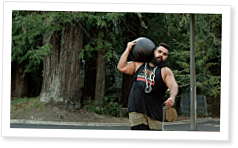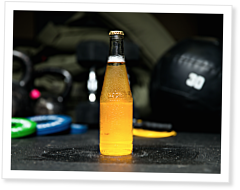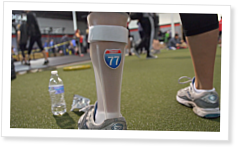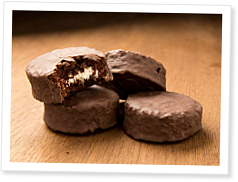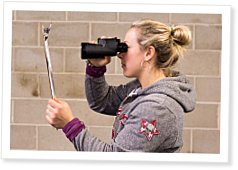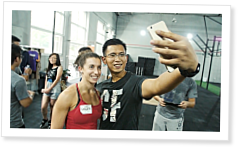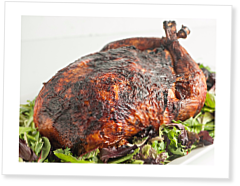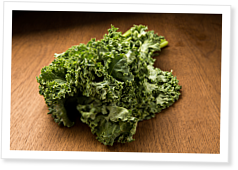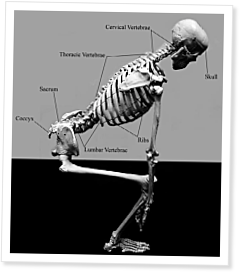by Austin Baraki, MD, SSC
“A charismatic speaker who can draw in your attention and trust…Prolific and confident use of highly technical, “pseudo-profound” jargon…All of this topped with a fine garnish of vaguely familiar-sounding buzzwords.”
Read More
var addthis_config = {"data_track_addressbar":true};
“Bullshit is everywhere.” – George Carlin
It’s true. Bullshit really is everywhere, whether you realize it or not, and people have been working out new ways to pass it off since the beginning of time. Politicians, businessmen, academics, lawyers, artists, mechanics, salespeople, journalists, marketers, and pretty much every other occupation has its own unique flavor of bullshit to offer. Consider, for example, all the things you routinely “filter out” when going about your day. You might hear a story on the news about the latest political scandal, see a commercial advertisement for a new magical fat-burning supplement, or quickly scan across the tabloid magazine headlines at the grocery store checkout line. You’ll smirk, scoff, or roll your eyes and think to yourself, “What a load of bullshit.” You probably don’t even notice how frequently this happens, because it’s a learned behavior that develops over time with accumulated experience. That said, age alone obviously does not guarantee a highly sensitive bullshit detector - it also requires vigilance, analytical thinking, and skepticism, because Bullshitology is a constantly evolving field. Today, I’m here to help fine-tune your personal bullshit detector specifically in the context of the Fitness industry, where the prevalence of Silly Bullshit is reaching epidemic proportions because of just how much money is at stake.I don’t claim to be an expert bullshitologist myself, and I know I’ve fallen for my own fair share. But I’ve always learned from it, and my tendency to think critically, logically, and scientifically whenever possible has helped open my eyes to the veritable cornucopia of bullshit the world has to offer. Some of the most prolific bullshitters tend to come from “alternative medicine” fields like naturopathy, chiropractic, and acupuncture, but equally impressive feats of bullshittery have been known to come from physical therapists, massage therapists, nutritionists, athletic trainers, “functional fitness” gurus, and yes, I’ll admit it, sometimes even physicians (see: Deepak Chopra & Dr. Oz). Since I can already sense some readers bristling at the implications here, allow me to explain. Note that I’m not arguing that these fields have absolutely no merit at all (that topic would involve a whole article series itself); today I’m simply arguing against the way they’re “sold” to us. Let’s start by examining how these folks craft steaming piles of bullshit that you’ll be tempted to happily accept, and then we’ll discuss what to do about it.The most common strategy that I’ll focus on today has a few basic components:
A charismatic speaker who can draw in your attention and trust,
Prolific and confident use of highly technical, “pseudo-profound” jargon,
All of this topped with a fine garnish of vaguely familiar-sounding buzzwords.
And when you think about it, these three components classically make up the standard arsenal in most sales or service-related fields. Recall the way a mechanic describes all the complicated-sounding components of your car that you thought were working just fine, but definitely need service for a number of vaguely plausible reasons. Or how about the salesman listing all the impressive-sounding, high-tech features of the new car, computer, gadget, appliance, or Turbo Encabulator that you never knew you needed? They’ll find ways to babble endlessly while actually saying very little of substance. Many practitioners in the list of fields I described above use the same strategy, and it’s critically important to recognize it before you get swindled. Of course, the “buzzword” repertoire will vary depending on the Bullshitter’s specific field of expertise, but the overall effect is to “anchor” the listener’s confidence. So let’s sharpen your senses by learning a few classic buzzwords (all of which I’ve listed in bold) that should serve as screening tools for Fitness Bullshitters out in the wild.Fitness Buzzwords: A Primer”Activation” and “Firing” of specific muscles, most commonly the Gluteus maximus, Spinal erectors, or Latissimus dorsi, which people believe can have “amnesia,” become “sleepy,” or otherwise “not fire” during basic movements. This then necessitates specialized “activation work” done regularly to “remind” them how to perform their anatomical function, and to ensure that you consciously contract each muscle in the “proper sequence” during complex movements. Of course, there’s no evidence supporting that any of this “not firing” actually occurs in the absence of neurological injury (e.g. nerve transection or other neuropathy, stroke, or spinal cord injury), muscle infarction, rare myopathies and metabolic disorders, or general anesthesia (i.e., pharmacologic paralysis). (As for “activation work”: there is some mixed evidence behind the idea of “post-activation potentiation” as it relates to subsequent muscular performance, but not as a “corrective” exercise. These movements can also be used as part of a warmup or to cue a desired effect. However, in the setting of effective coaching these are typically unnecessary and waste valuable training time, especially when recommended on a regular basis.)» Bottom line: These are bullshit diagnoses, so watch out for people throwing these words around. If you are able to stand up from a chair or walk up a flight of stairs without lurching or falling, your glutes are “activating”, and any failure to properly utilize them in a squat likely represents a failure of your coach, not of your neuromuscular system.”Fascia,” the tough sheets of connective tissue in and around your muscles and organs that are often claimed to have far-reaching physiologic functions, affecting so many bodily systems that they must be the root cause of all of your problems. Detailing all of this bullshit will require its own article in the future; for now, suffice to say that none of this has ever been demonstrated to be remotely true. Practitioners often inexplicably (and inconsistently) diagnose fascial “distortions,” “restrictions,” or “adhesions” (more buzzwords) that have no reliable, objective clinical findings, and probably have no basis in reality either. These problems, of course, are causing whatever symptom you’re complaining of (or aren’t complaining of), and therefore need to be “released” using manual/massage therapy or other “soft tissue work”. Now, I won’t deny that getting a massage or other such modalities makes us transiently feel better - although this could easily be placebo effect as suggested by comparisons with “sham” treatment, and by the “central model” of fatigue. I’m arguing against the preposterous evidence-free theorizing that these “specialists” confidently use to sell you on their treatments. » Bottom line: Watch out for people who talk about your fascia. There is no reliable evidence supporting these bizarre claims about 1) the physiologic significance of fascia beyond its structural function, 2) that any of these supposed pathologies actually occur and have clinical manifestations, or 3) that manual/massage therapy can meaningfully affect fascial tissue structure at all.”Functional,” a classically meaningless word that is used to justify a lack of strength. You’ll hear the description of “functional strength” as some nebulous variety of strength that is somehow more useful than the “brute strength” derived from squats, presses, and pulls. Somehow the strength represented by a 700 lb deadlift becomes useless in any other context, but the ability to perform an overhead pistol squat with 65 lbs is truly “functional” (...for what task, exactly?). These “functional movements” are often complex and attempt to integrate as many “domains of fitness” as possible into a few movements, diluting the overall stimulus and therefore diluting any resultant adaptations.» Bottom line: There is no such thing as “functional strength.” Strength is the ability to produce force against an external resistance, and producing more force is more “functional” compared producing less force. Period. {pagebreak} ”Core Strength / Stability,” an obsession since the explosion of the fitness industry, specifically describing the function of the trunk musculature. Yes, it is a real thing, and it is important in bracing the torso to allow for safe, efficient force transmission. This bracing occurs mainly by the relevant muscles contracting (i.e. producing force) to hold a rigid torso. Many practitioners will confidently diagnose a “weak core” based on a number of nonspecific symptoms and silly, unreliable clinical tests (1). This is often a “cop-out” diagnosis unsupported by objective and reliable clinical findings, so you should be suspicious of anyone who definitively diagnoses this as your problem. They might then prescribe dedicated “core strengthening exercises,” typically consisting of bodyweight calisthenic-type movements (e.g. yoga, pilates, etc.) or silly exercises on unstable surfaces that are often not linearly scalable or trainable, and are not an ideal use of most people’s training time. Even if you do have a “weak core,” just increasing the time spent in a particular position beyond a certain point fails to demand further increases in force production, and therefore is limited in its ability to keep getting you stronger. » Bottom line: Save your time by training your squats, presses, and deadlifts with appropriate weights that require your core musculature to exert the amount of force necessary to hold a rigid torso, then incrementally increase these weights (and therefore the force demands) over time. This results in objective, quantifiable increases in the strength of your “core” muscles as well as many others that yoga stretches simply can’t provide.”Mobility” is perhaps the biggest fad term of the past 10 years and still doesn’t even have a particularly clear or established definition, especially when compared to the term flexibility. It seems to represent having uninhibited range of motion about a joint, particularly when under load (though I’m sure there are hundreds of even more ridiculous definitions out there). I like to poke fun by calling it “Functional Stretching!” But people now seem to think that everyone should routinely “do mobility work” all the time as “self-maintenance,” regardless of symptoms or of actual needs based on a particular sport or activity. Some of these folks spend hours each week “mobilizing” themselves using a whole gym bag full of balls, bands, rollers, and other self-torture devices instead of actually getting strong. Furthermore, lots of practitioners will prescribe “mobility work” as another catch-all treatment for whatever ails you, similar to the “fascia” crowd or the “core” people (seeing a pattern here?). Back pain? You obviously need more thoracic mobility. Shoulder pain? Probably need more shoulder mobility, bro. Hip pain? Gotta open up those hip capsules, man. Look folks, this is not how things work. Pain is way more complicated than this, and much of the time it doesn’t even correlate with structural abnormalities (more on this in the future)! I can’t deny that an early morning stretch feels nice after waking up, and you’re welcome to stretch to your heart’s content if it makes you happy (although it’s not helping you warm up, produce more force, prevent injuries, soreness, or recover any faster (2-4)), but this obsession with getting “Supple” is downright delusional. » Bottom Line: Are you able to correctly hit the positions required in your training? Then you have adequate mobility. Are you unable to correctly hit the positions required in your training, despite competent coaching? Then you might need some “mobility work,” to be determined on an individual basis.”Flossing” basically involves wrapping a rubber band around a muscle or joint, but apparently there are now ways you can “floss” your nerves too [citation desperately needed]! This is one of my absolute favorite buzzword terms because it has perplexed me since the very first time I heard it, and I’m still not exactly sure just what the hell it means. Of course, I’ve seen countless impressively confident explanations of what it does and how it works, so I’ll let a few internet pseudo-experts babble for themselves (I’ve bolded the parts representing completely made-up, Grade A Gobbledygook):
[Flossing] “helps break up intramuscular junk to allow for greater mobility and blood supply to an area. By squeezing the muscle in a tight wrap, then forcing it through a full range of motion (ROM), friction between muscle fibers helps break up fuzz, scar tissue, lactic acid and other junk in those tiny places that foam rolling and lacrosse ball techniques can’t address.”
“Flossing allows you to move into the position that is restricted and encourage it to open up, receive more blood-flow, and break down lines of tension in those movements through performing the problem-actions while being compressed at the joint. It can restore sliding-surface function to the underlying matted-down tissues, resolve joint pain, and improve muscle contraction incredibly.”
“With voodoo flossing the compression forces tissue adhessions [sic] to forcefully slide against each other with minimal tissue displacement. This forced glide not only resolves myofascial dysfunction due to aberrant tissue formation, but also indirectly (or very directly depending of the therapist’s intent) acts as an effective neurodynamic tensioner technique. The increase of ROM is not only driven by inhibition of tonus, but also by increased neural drive. Functional movement assessments and HEP are key to maintaining changes.”
Really? Can anyone really know if that’s how all this stuff actually works? Not a single word of any of these claims is in any way supported to the extent suggested by the speakers’ confidence in their claims and pseudo-technical jargon. It is abundantly clear that these folks have absolutely no idea how the neuromuscular or circulatory systems actually work, but they sure sound like experts! Take note here that I’m not even suggesting that “flossing” is completely ineffective (although there’s probably a degree of placebo at play). Rather, I’m arguing that we have absolutely no clue whether or how it might work. But you’d never be able to guess that from this bullshit, which is far more likely to part you from your money than saying “...Eh, it might do something…? We dunno.” » Bottom Line: Carefully evaluate the claims of anyone telling you to floss anything other than your teeth.Any specifically named, usually smaller muscle (e.g. Quadratus lumborum, Psoas, Piriformis, Transversus abdominis, Gluteus medius, etc.), usually representing the “pet muscle” of a particular therapist or guru. They’ll always find a way to diagnose some vague “dysfunction,” “tightness,” “weakness,” or “imbalance” (more fun buzzwords) of their pet muscle in just about every person who walks in the door, because it’s been criminally underappreciated by the “mainstream” (thereby contrasting themselves as more “educated” and “holistic”). And of course, since they’re the self-proclaimed guru for that particular muscle, who else should be the one to waste your next six months of time with corrective exercise “progressions” and “mobility work”? » Bottom line: Perhaps instead of focusing on “activating” one tiny muscle with corrective exercises or obsessing over your Psoas, all you need is a coach who actually knows how to get you to lift symmetrically, how to valsalva effectively, or how to set your back properly in the context of the lift itself. You know, coaching. Radical idea, isn’t it?This is fun, isn’t it? I could go on with other abused buzzwords like “Torque,” “CNS,” “Dysfunction,” “Hip Hinge,” “Centration,” “Dynamic,” “Alignment,” “Dyskinesia,” “Maltracking,” and so forth, but perhaps I’ll save them up for a future piece. For now it’s time to move on. It should be noted that these buzzwords do have perfectly legitimate uses in the English language, so they don’t automatically imply that they’re swimming in a context of bullshit. Instead, they just grab my attention and make me think extra carefully about the words that follow, particularly when used in the contexts I described.{pagebreak}How it worksOnce the fitness guru or therapist has captured your interest with some familiar buzzwords, they’ll veer off into uncharted territory full of wild, unsupported theories that, to a layperson, sound just plausible enough to be true - in part because of how confidently they’re delivered.They speak with such certainty that you can’t help but nod your head in a mesmerized daze, and they’re often able to speak this confidently because they don’t actually realize how much they don’t know. (This relates to why certain professions are more prone to this phenomenon than others). They’ll fixate on the anchoring buzzword of choice, then transition into an eloquent explanation of why you’re obviously broken, why the “mainstream” fails to recognize this problem, and why you therefore need their unique expertise to get fixed. They prey on the types of people who need to find something wrong with themselves, and who are easily convinced by these fanciful explanations.Suddenly, your pain is obviously explained by vertebral “subluxations” (which don’t actually occur) requiring lifelong chiropractic adjustments, or by interruptions in your “qi life force” requiring acupuncture needling along specific “meridians” (which don’t actually exist) (5-7). Or, if you visit a different practitioner, your problems are diagnosed as “mobility restrictions,” “soft tissue dysfunction” or “fascial distortions” that need to be worked out with regular corrective exercise, manual therapy, or daily flossing. Whoops, looks like I accidentally let loose some of my opinions about those fields there. Sorry! (I’m not sorry.) One of my biggest problems here is that, because there is no objective evidence for these supposed pathologies, there is essentially zero inter-rater reliability among bullshitters. What I mean by this is that if you take the same exact complaint to a handful of different bullshitters, each one could potentially give you a different diagnosis (likely one that falls within their field of “expertise”) requiring their services to treat. That’s the luxury of being able to completely make shit up. This is analogous to going to the Emergency Department complaining of chest pain and, purely depending on who you happen to see, having a Cardiologist diagnose you with a heart attack, a Pulmonologist diagnose you with a collapsed lung, a Gastroenterologist diagnose you with acid reflux, or an Orthopedist diagnose you with a Rib fracture. See the problem here?On SkepticismSo now that we’ve seen some examples of how Silly Bullshit works, how do we deal with it? Analytical thinking and maintaining a healthy basal level of skepticism are quite valuable when coming face-to-face with a real bullshitter out in the wild. A decent definition of skepticism is “any questioning attitude towards unempirical knowledge or opinions/beliefs stated as facts, or doubt regarding claims that are taken for granted elsewhere” (8). The first part makes intuitive sense: if someone claims a belief as absolute fact, it should definitely smell a little funny to you, and you should ask some probing questions to dig a little deeper. Next, claims that are simply taken for granted without convincing reasoning or evidence tend to have that same familiar odor and also deserve questioning. At this point you’re almost guaranteed to hear the phrase “Yeah, well you don’t have any evidence that this doesn’t work!” Always remember that the burden of proof lies on the person making the claim, and until that occurs, it always pays to stick with the “Null Hypothesis.”Now, I’d take the above definition a step further and suggest that there is room for skepticism in the realm of “empirical” knowledge too (i.e., that which can be observed or experienced). Our senses are far from infallible, and we’ve all had instances where our senses deceived us, or where we “saw” what we wanted to see and brushed off any conflicting observations. This latter phenomenon is known as confirmation bias, and it leaves just enough room for an expert bullshitter to get his foot in the door. In addition, research studies often claim to provide “empirical data” on a topic. These are prime targets for bullshitters with an agenda. The internet has millions of comment threads full of “PubMed wars,” where people do battle using links to research Abstracts that fit their preconceived notions and conclusions. Folks, just because it’s “science” doesn’t mean it’s not a hot, moist, steaming pile of bullshit. Study methods, data gathering, and analysis are all heavily prone to bias, manipulation, and misinterpretation. There is an entire industry of “predatory journals” out there that will literally publish anything as long as you pay them their damn publication fee. So we must remain skeptical when it comes to scientific literature too; always consider the source and examine the validity of what the researchers actually did. And if you’re not qualified or comfortable making these assessments, find people who are. In short, to effectively sift through the bullshit one must take an approach best described by our own Dr. Sullivan, who said of one particular study “Right off the bat, I’m skeptical of this study. Why? Because I like its conclusion.”The approach to a suspected BullshitterMy preferred approach when dealing with a potential Bullshitter involves deliberately and systematically stripping away all the bullshit. Repeatedly ask “Why?” and “How?” Force them to define their terms clearly and to speak in simple English rather than in ambiguous, pseudo-profound run-on sentences. Break down the argument slowly, or physically transcribe it into its component pieces (particularly if the suspected Bullshitter is a fast talker). Then, you’ll find that one of two things happens. Either you catch them and expose their bullshit (at which point many of these folks might stubbornly double down, use logical fallacies and ad hominem attacks, accuse you of being “closed minded,” “brainwashed by the mainstream,” or some other such attempt at evading the question), OR you eventually dig down to a foundation where you can agree, then work your way back up through the argument piece by piece using clear language and logical reasoning. The former situation is obviously the more common with Silly Bullshitters, whereas the latter is more common with folks who actually know what they’re talking about, but have difficulty communicating it clearly the first time around. This latter situation is actually a “false positive” that smells a little like bullshit, until you work through it more methodically.So today we’ve laid a solid foundation on how to screen for, identify, and deal with Silly Bullshit and those who espouse it. Starting with this article, we will begin running more regular pieces on StartingStrength.com that will examine and debunk specific real-world examples using the ideas we’ve laid out today, so look out for those coming up soon. You’ll find these concepts will come in handy in every area of life, so stay vigilant, stay skeptical, and always keep the switch of your Bullshit detector firmly in the “on” position. It’ll end up saving you time, money, and frustration for the rest of your life. Austin Baraki, M.D., Starting Strength Coach is a resident physician in Internal Medicine at the UT Health Science Center at San Antonio, Texas. He received his doctorate in Medicine from Eastern Virginia Medical School in Norfolk, Virginia and his B.S. in Chemistry from The College of William & Mary in Williamsburg, Virginia. He became interested in strength training after completing a 15-year competitive swimming career through the Division I collegiate level, and is now a competitive powerlifter and strength coach for clients of all ages. As of 2015 he had achieved personal best lifts of a 530 lb squat, a 405 lb bench press, a 600 lb deadlift, and a 1505-lb raw competition total at a bodyweight of 192 lbs. He can be reached directly by email at DrAustin@barbellmedicine.com.References(1) Weir A, Darby J, Inklaar H, Koes B, Bakker E, Tol JL. Core stability: inter- and intraobserver reliability of 6 clinical tests.(2) Kay AD, Blazevich AJ. Effect of Acute Static Stretch on Maximal Muscle Performance: A Systematic Review. Med Sci Sports Exerc. 2011 Jun 8.(3) Herbert RD, de Noronha M, Kamper SJ. Stretching to prevent or reduce muscle soreness after exercise. Cochrane Database Syst Rev. 2011;(7):CD004577.(4) Hart L. Effect of stretching on sport injury risk: a review. Clin J Sport Med. 2005 Mar;15(2):113-113.(5) Ernst E. Chiropractic: a critical evaluation. J Pain Symptom Manage. 2008 May;35(5):544-62.(6) Madsen MV, Gotzsche PC, Hrobjartsson A. Acupuncture treatment for pain: systematic review of randomised clinical trials with acupuncture, placebo acupuncture, and no acupuncture groups. BMJ. 2009;338:a3115.(7) Ernst E, Lee MS, Choi TY. Acupuncture: Does it alleviate pain and are there serious risks? A review of reviews. Pain. 2011 Apr;152(4):755-64.(8) Skepticism. (2015, November 17). Wikipedia, The Free Encyclopedia.


